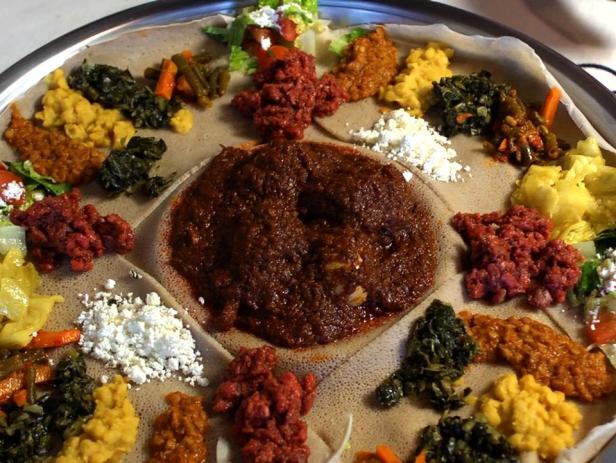Chef's Special
Injera (sourdough flatbread)
“Injera is not a dish itself, but the vehicle for almost every single meal in Ethiopia,” says Richman.
She’s not kidding: When I was in Addis (as everyone calls it) last year, even a breakfast of stir-fried injera, known as fir-fir, was served with even more injera on the side.
As mentioned, eating Ethiopian almost always means eating with your hands.
In lieu of silverware, injera is used to scoop up whatever is served, from collard greens to lentils to nubs of meat.
Emily Post acolytes needn’t freak out, since injera has its own etiquette.
As Richman instructed me last year, first you rip off a piece of bread from the communal supply, then you rip off smaller pieces from your portion as you go, using them to scoop up individual bites.
All of this should be done with the right hand.
(Here’s a
video courtesy of Addis Eats to help you master your injera game.)"
Its Recipe
Ingredients
- Teff grain
- 1/4 cup teff flour
- 3/4 cup all-purpose flour
- 1 cup water
- a pinch of salt
- peanut or vegetable oil
- a mixing bowl
- a nonstick pan or cast-iron skillet
How to cook Injera
make sure that,
Put the teff flour in the bottom of a mixing bowl, and sift in the all-purpose flour.
Slowly add the water, stirring to avoid lumps.
Put the batter aside for a day or more (up to three days) to allow it to ferment.
In this time, your injera batter will start to bubble and acquire the slight tanginess for which it’s known.
Note: If you find that your injera batter does not ferment on its own, try adding a teaspoon of yeast.
Stir in the salt.
Heat a nonstick pan or lightly oiled cast-iron skillet until a waterdrop dances on the surface.
Make sure the surface of the pan is smooth: Otherwise, your injera might fall apart when you try to remove it.
Coat the pan with a thin layer of batter. Injera should be thicker than a crêpe, but not as thick as a traditional pancake. It will rise slightly when it heats.
Injera
